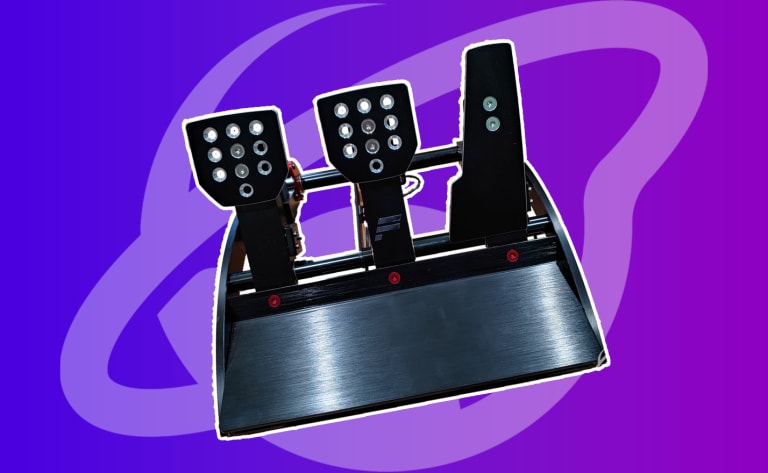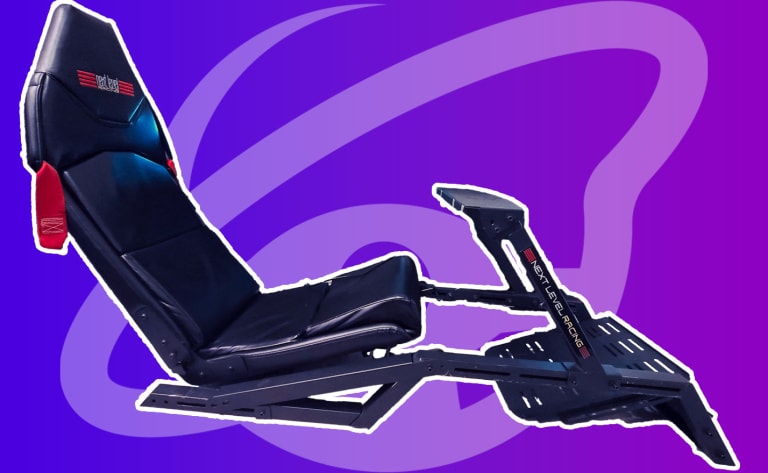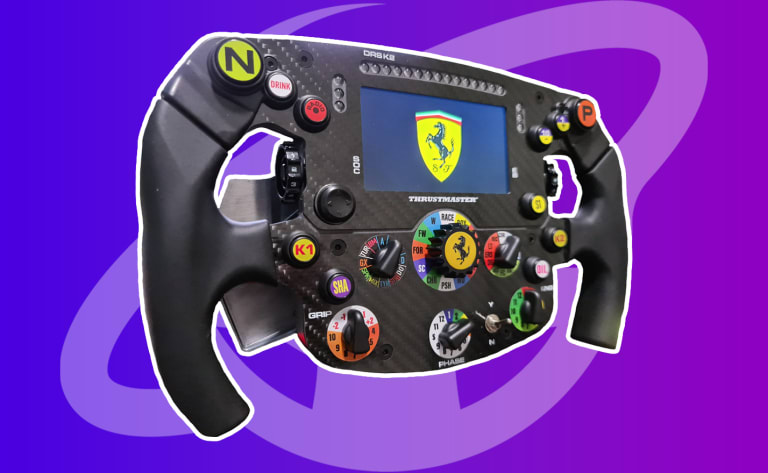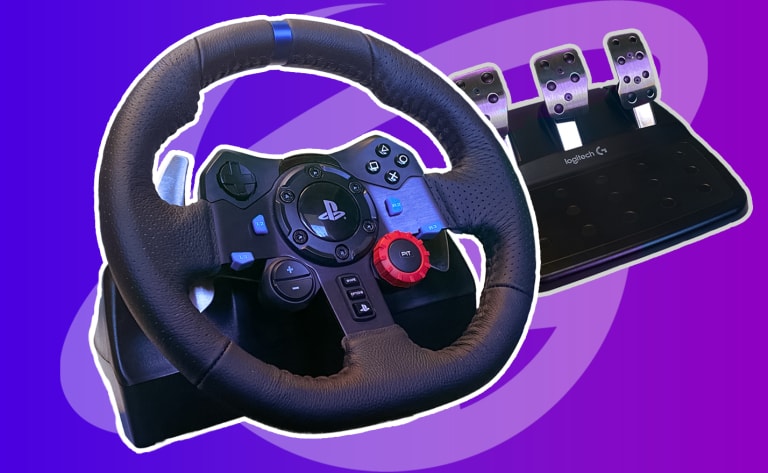Thrustmaster TMX Review
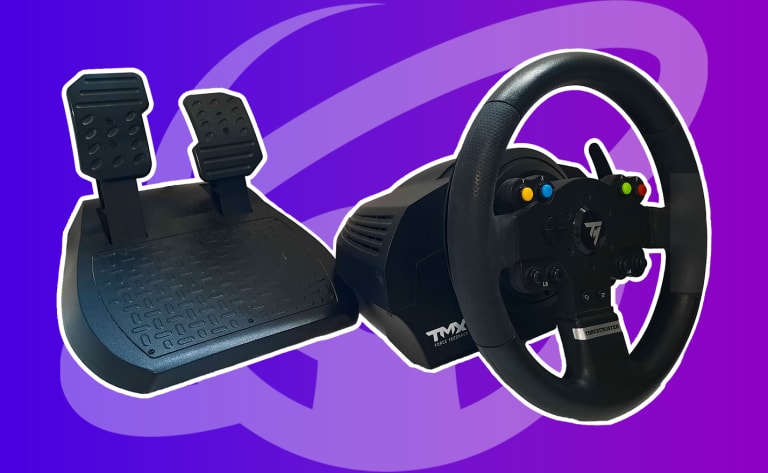
Through the 5+ years I have been sim racing, the Thrustmaster TMX stuck with me for the longest time of over 2 years.
It has gotten a lot of abuse from me over the years. It has been used for endurance races, drift and time trials. You name it.
With over 2,000 hours of sim racing, I have put it to the test several times, and let me tell you, it is an excellent unit, as you’re about to find out in this review.
Data for Thrustmaster TMX:
Thrustmaster TMX Wheel:
Min. turning radius: 270
Max. turning radius: 900
Diameter (in cm): 28
Thrustmaster TMX Wheelbase:
Torque (in nm): 2
Thrustmaster TMX Pedals:
Amount of pedals: 2
Table of Contents
Early impressions
The Thrustmaster TMX is one of the best Force Feedback Wheels you can get for under €200.
Why, you ask?
Because it has decent force feedback and arguably a more superior hybrid of a belt-driven and gear-driven system, compared to the G29, giving the wheel a degree of smoothness other wheels in this price range don’t have.
We’ll now discuss why the TMX is beating the Logitech G29/920 in some cases and why it’s great for its price range.
What's in the box?
In the box, you will get the Wheel (TMX for Xbox and PC only), a 2 Pedal Set and a Desk Mounting Clamp.
Wheel & wheelbase review
Looks
Coloured Buttons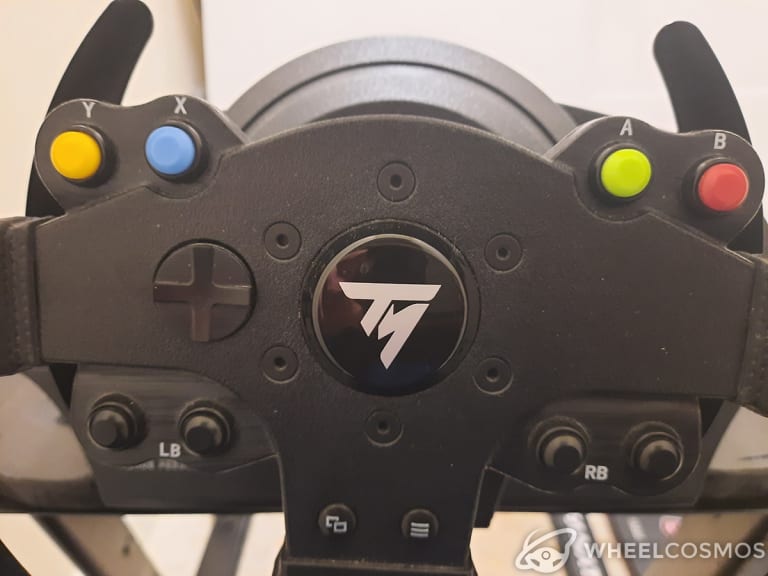
The TMX wheel is all black with coloured buttons corresponding to its Xbox controller counterpart (X button is Blue, Y button is Yellow, Etc).

The rim itself is 28 cm/11” in diameter, making it a bit bigger than the 26 cm/10.2” that the Logitech G29 comes with.
This makes the rim size a good middle ground for most people.
Attached to the centre of the wheel’s rim is a sleek Thrustmaster logo and below it a silver band with the company name.
Build quality
The outside of the TMX is plastic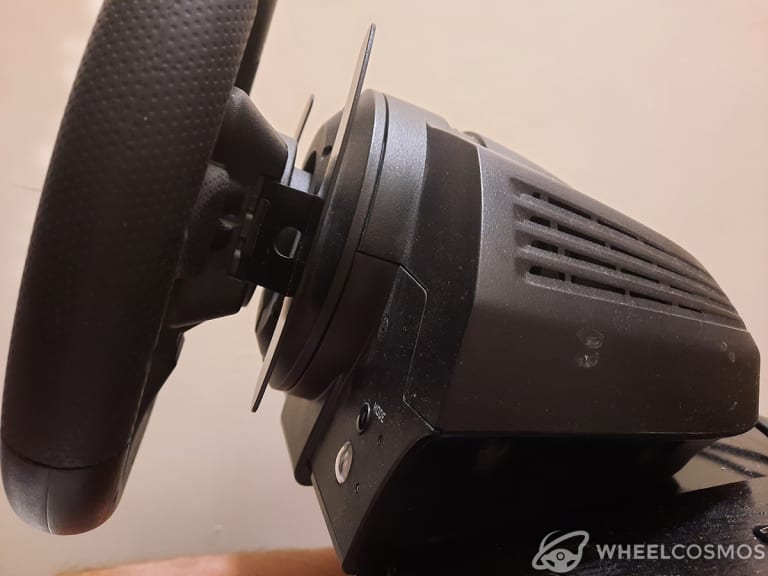
Build quality is where we think Thrustmaster can really improve. Everything you see on the outside of the wheel is plastic.
Rubber grips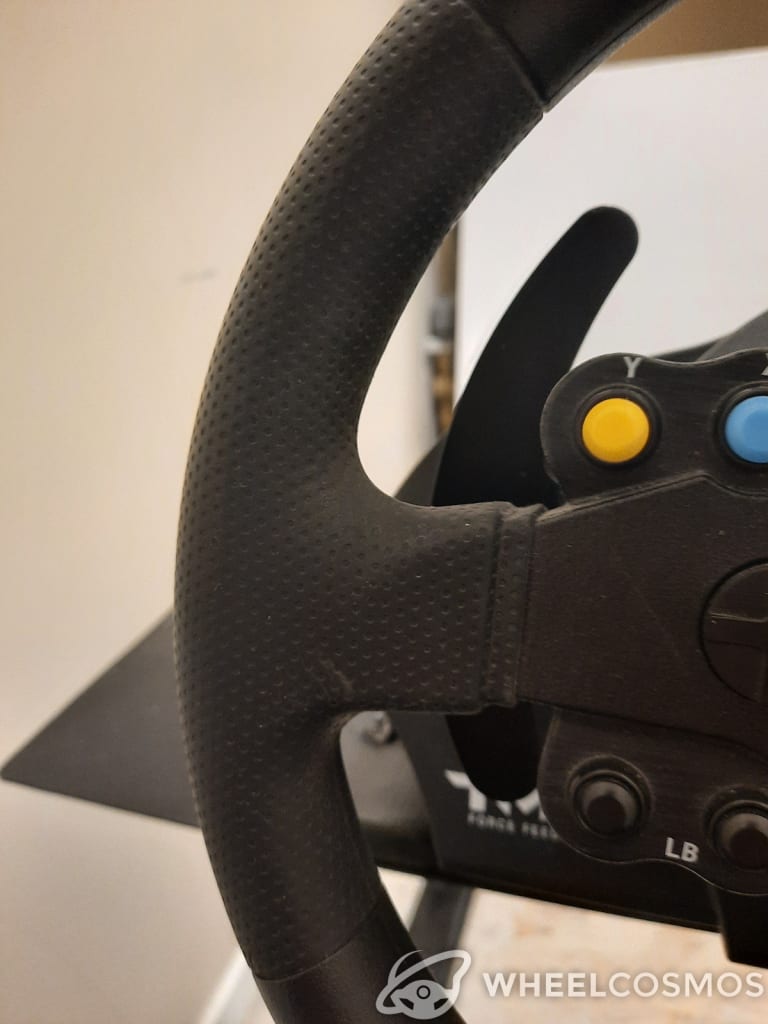
Compare that to the G29, which at least has a metal faceplate on the rim and nicer, leather grips.The TMX also has some rubber grips, but they are mediocre at best.
Rubber starting to wear off after heavy use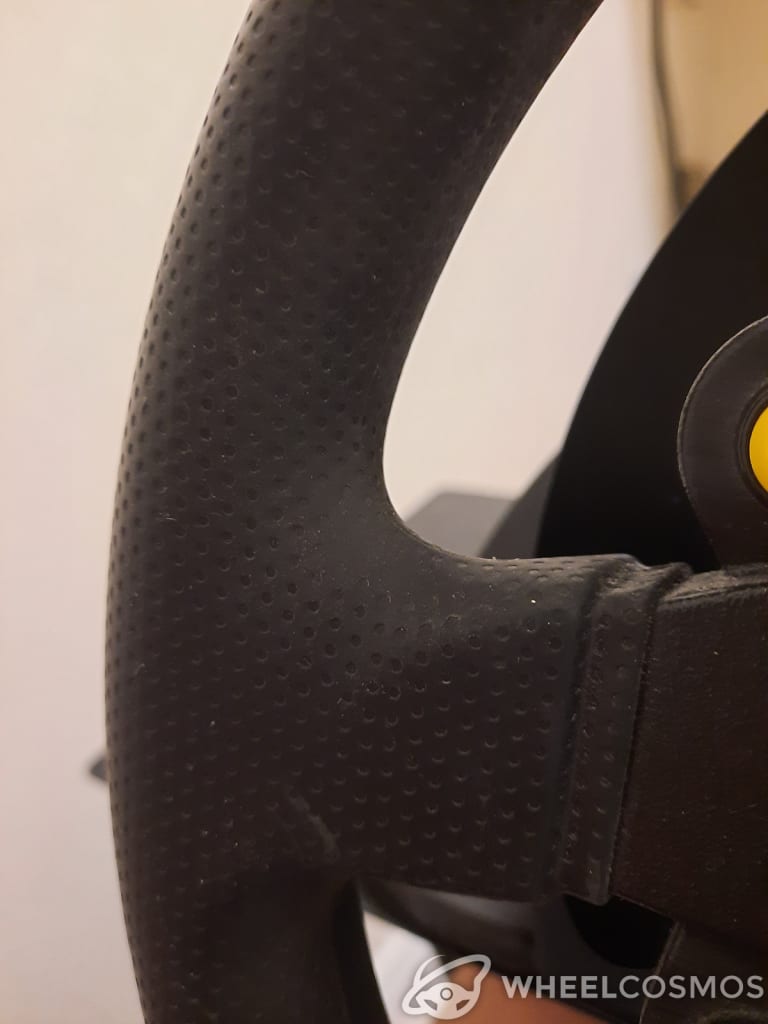
After about 500 hours of use, we noticed the rubber starting to wear off around the thumb and index finger area.
The rim is fully plastic, except for the paddle shifters, which are metal and feel solid to the touch.
These do come in a little mushy when pressed. While pressing down on the paddle, we noticed that about 80% of the way in, the paddle activated, making the end of the click slow and hollow.
This can slow down someone’s shifting performance, since they have to push in more than is needed.
As for the other buttons:
They are almost as good as their Xbox One controller counterparts. Although they are a bit mushier, and we did start to notice some buttons showing vastly less resistance after about 700 hours of use.
However😀espite the use of plastic, the wheel is holding up pretty well and is very rigid.
Extra features
14 programmable buttons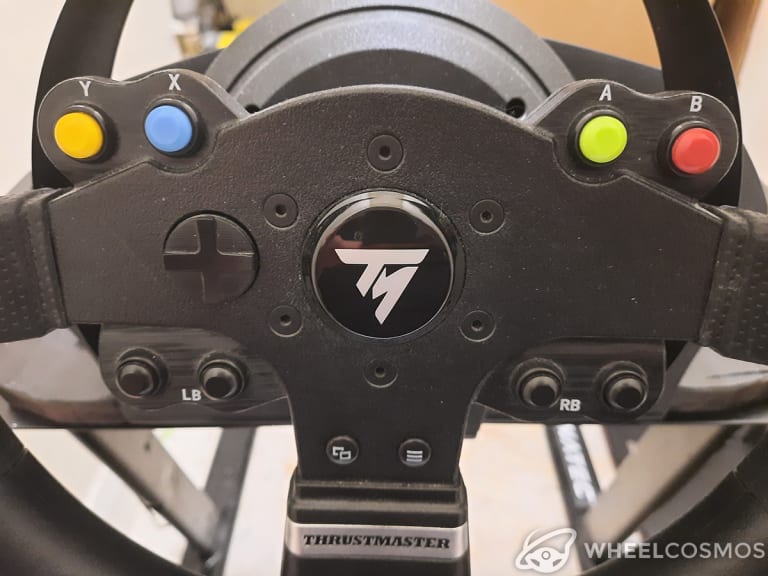
The TMX wheel has 14 programmable buttons on the faceplate of the rim. They all correspond to the Xbox One Controller, with the X, Y, A and B buttons all being coloured.
These are not what we would describe as Xbox or PlayStation quality buttons, but they do the job. What it does lack is dials and possibly a rev counter, which the G29 includes.
Personally, we would love to see an updated version of the TMX with these features, even if it is at a higher cost.
Moving away from physical features, let’s talk about the software features.
Software features
Adjust wheels and pedals axis and activation points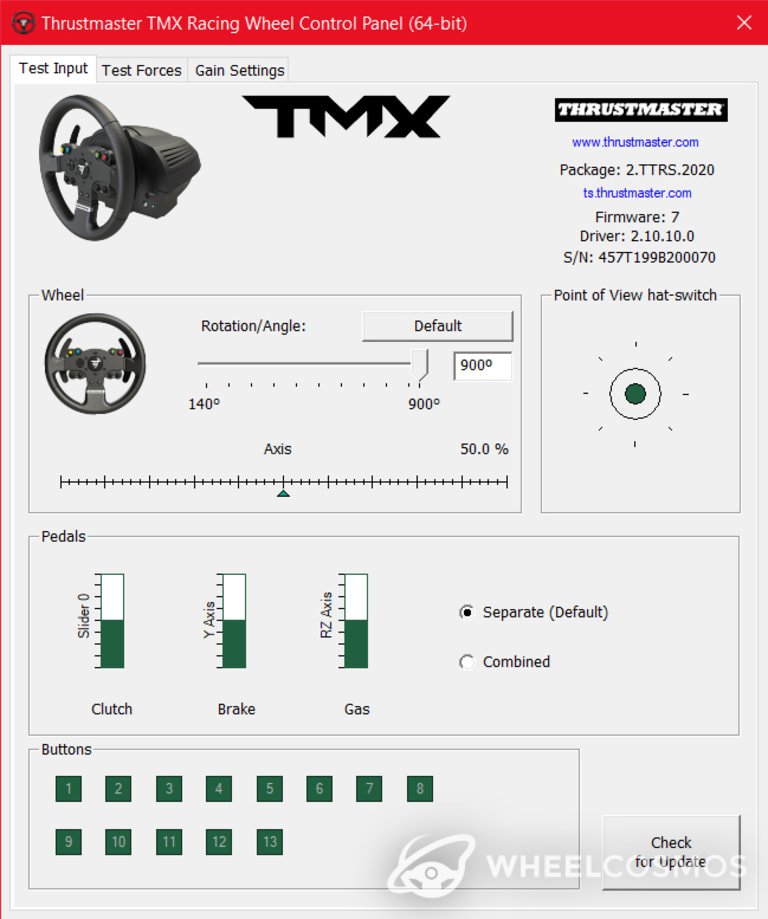
To use the wheel on PC, you need to install the Thrustmaster drivers, which come with a menu in which you can customize the wheel.
The Thrustmaster TMX software allows you to see your wheels & pedals axis and activation points.
Test the force-feedback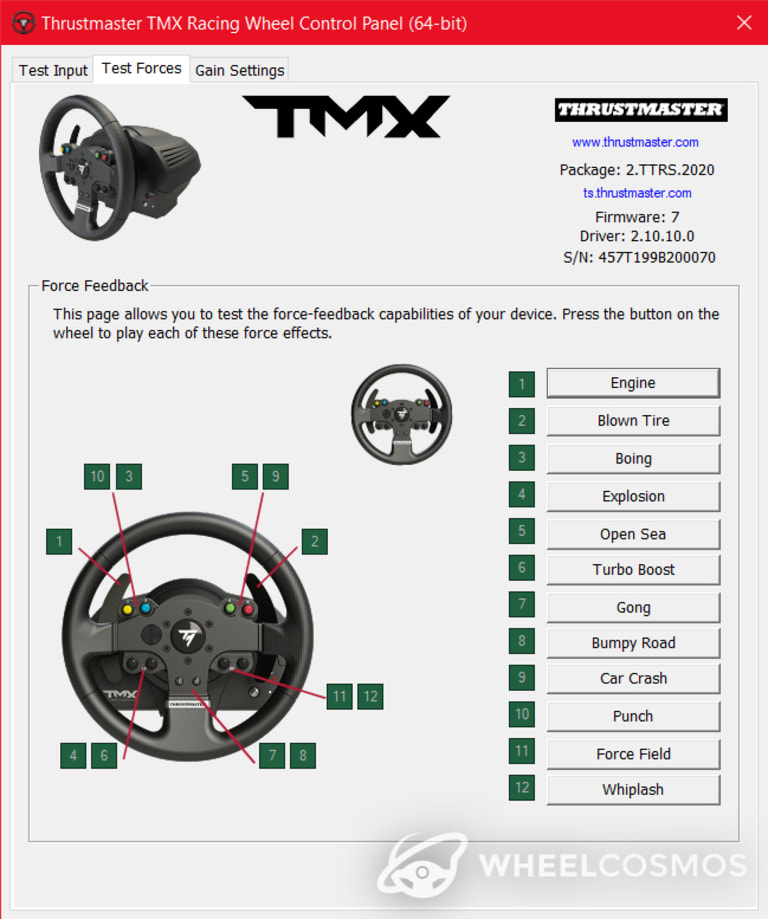
You can also edit the wheel’s 900 degrees of rotation to anything below that if you wish. There is also a menu full of scenarios to test your wheel’s force feedback.
Personally, we did not find this extremely helpful. It works well if you are testing your wheels force for any degradation, but that’s about all it’s good for.
Gain settings - adjust the strength of the forces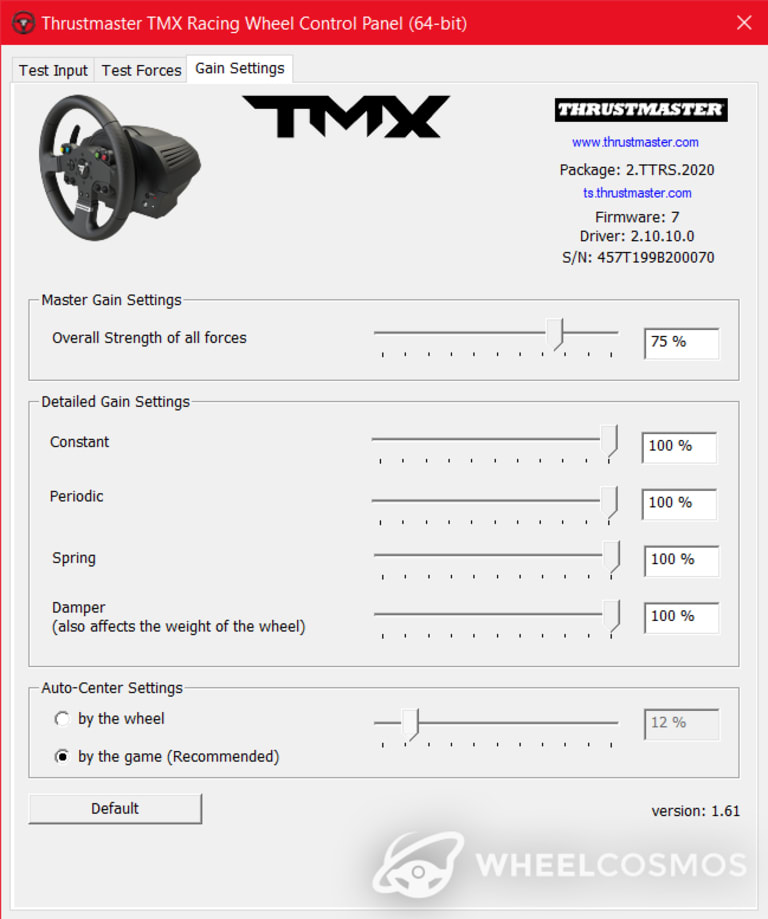
A Gains menu is also present, allowing you to alter how much force is put through the wheel and how much force feedback there is. Apart from that, there is not much to adjust in the software itself, which is a downside.
We would like to see some more features like changing the pedals’ actuation force, or even a simpler calibration. I feel like this makes the software feel unfinished and more to be desired.
Engine and force feedback
The TMX wheel is powered by a mix of a belt-driven and a gear-driven motor with a 12-bit, optical sensor. The benefit over a “pure” gear-driven motor (like the G29) is, that it’s a lot smoother and less noisy.
On the other hand, the G29 uses a hall-effect sensor. Compared to the optical sensor (which works by converting light into an electric signal) of the TMX, the hall-effect sensor of the G29 is more reliable.
That’s because of its precision and how hard it is to manipulate or break from an outside.
For techies: Optical vs. Hall-effect Sensor
An optical sensor works by converting light into an electric signal. So, basically, it’s scanning how much light comes back.
The hall-effect of the G29, on the other hand, is using magnets ⇒ less complicated & more reliable.
But the TMX has one important benefit over the G29 nonetheless:
It’s a belt/gear drive hybrid wheel, which makes the motor’s movements less stepped and way smoother than the G29, which is using just gears.
These gears have a more pronounced stepping movement in them. But it’s still not very noticeable. What is noticeable, though, is that the TMX is a lot quieter than the G29.
Although it does lack behind, since Logitech is using dual motors instead of Thrustmaster’s single motor. Because Logitech opted for dual motors, the Force Feedback will be more defined and precise.
Despite that, the TMX feels really smooth and consistent. But we have found that when the wheel is sightly turned towards its centred position, you start feeling a little stepped movement, almost like if it was gear-driven.
Don’t worry!
It’s not enough to put you off while driving. But we did notice that, and it could be fixed with some adjustment to the gear on the motor itself.
The accuracy of the wheel is also fantastic. The 12-bit optical sensor is very responsive and there is no visible delay in the input.
And now the important part: Does the cheapest Force Feedback Wheel have good force feedback?
Well… sort of.
It definitely is not the strongest force feedback. Comparing to a G29, It is certainly lacking.
But it’s consistent and powerful enough to satisfy a beginner!
The G29 does have more power, but the single TMX motor does an excellent job. It delivers about 2Nm of torque, just short of the G29’s 2.2Nm of torque.
What’s torque?
Torque is the rotational energy, basically how much energy is in the rotation. The more torque (Nm), The stronger the force feedback will be.
After using it for over 2,000 hours, we can say that the force feedback does become looser and less pronounced.
It almost feels gritty and very stepped, almost like it’s JUST gears, and nothing else. It definitely takes a lot away from the experience.
Hardware failures
Don’t skip this section! No one wants their wheel to die after just a few weeks of usage.
But the TMX really isn’t that bad. We would like to mention a few flaws that could lead to failure, though!
What we found is an overheating problem and a problem with the strength of the wheel hub (the part between the wheel and the wheelbase).
Overheating can be caused by using your wheel at extreme Force Feedback levels for long periods. This could potentially burn out the motor.
My personal experience?
After an endurance rate, my unit has overheated. So be cautious of that!
Wheel Hub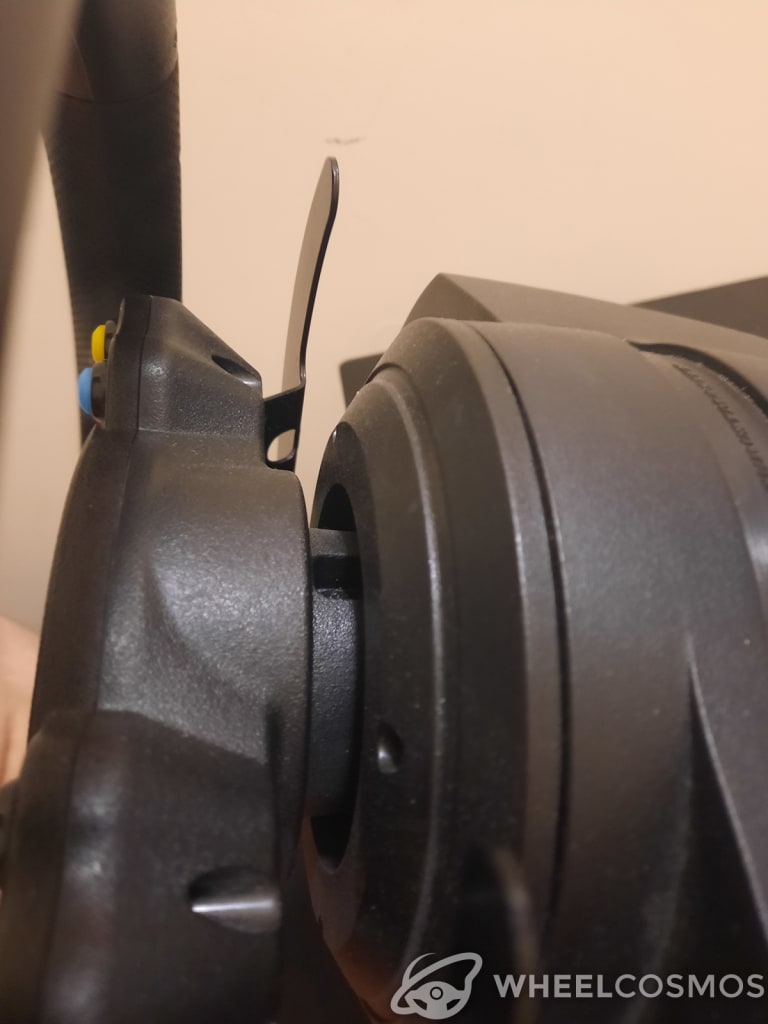
The wheel hub has some give to it if pushed or pulled to/away from the wheelbase.
Many people actually do that: pulling or pushing their wheels. So, that’s something to keep in mind.
I, personally, tend to pull on my wheel as well, so I did notice some flex in it. Could potentially lead to failure in the future.
Mounting options
Plastic desk clamp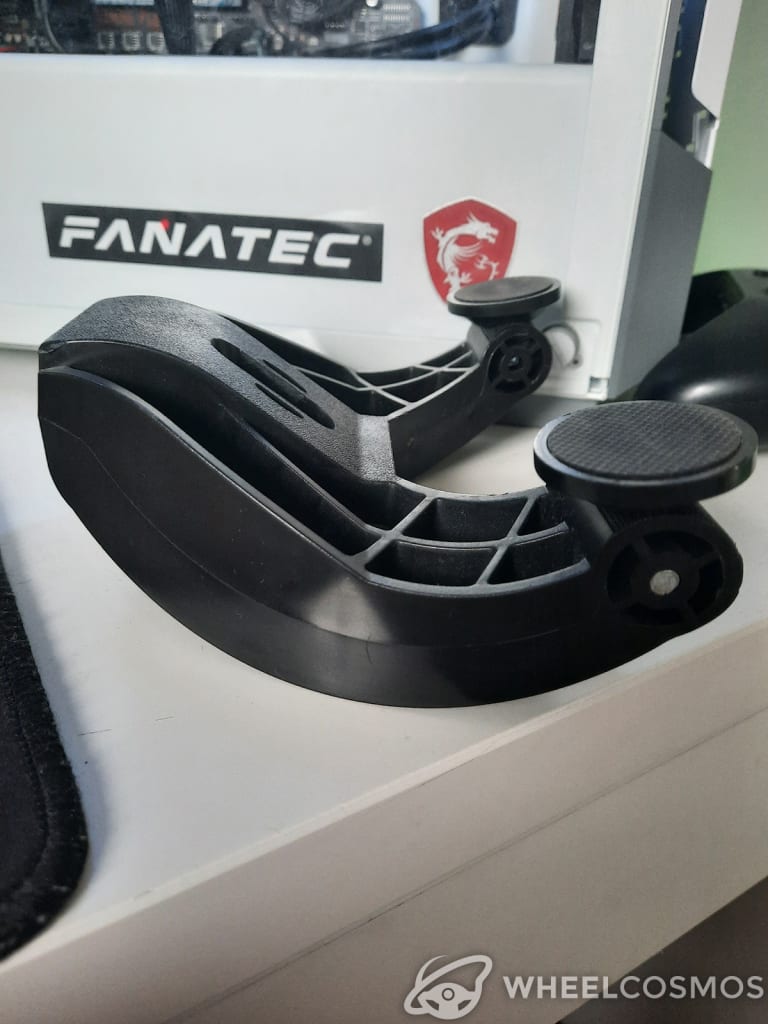
Here comes the worst thing of this wheel: Mounting options.
Unfortunately, the only mounting option is a desk clamp — FULLY out of plastic.
And yeah, you can guess how sturdy that will be.
We went through 3 clamps already because each one broke under force, or the screw just snapped clean off.
Hardware mounting to a rig? Not possible with this wheel — unless you want to modify it.
We used a threaded hole and self-cut, wooden stabilisers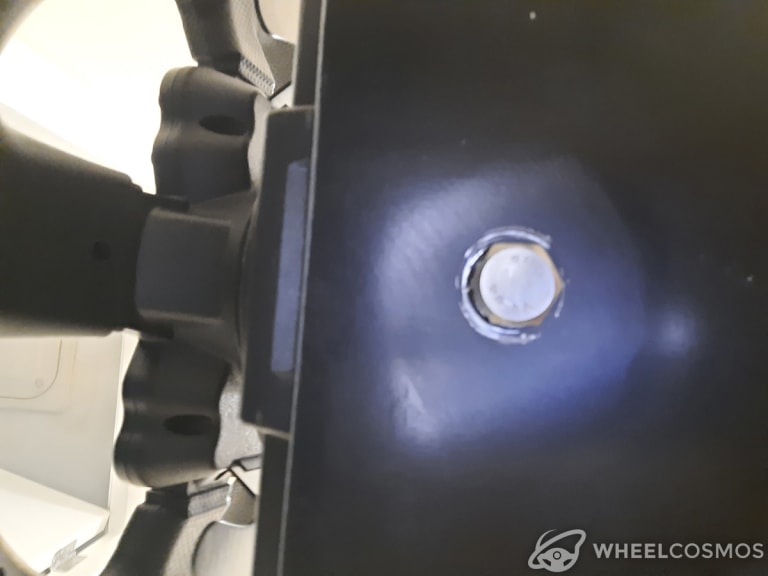
Our solution:
We used the existing threaded hole for the clamp as a mounting point. The wheel was stabilised with self cut wooden stabilisers on each side.
Mounting: Screws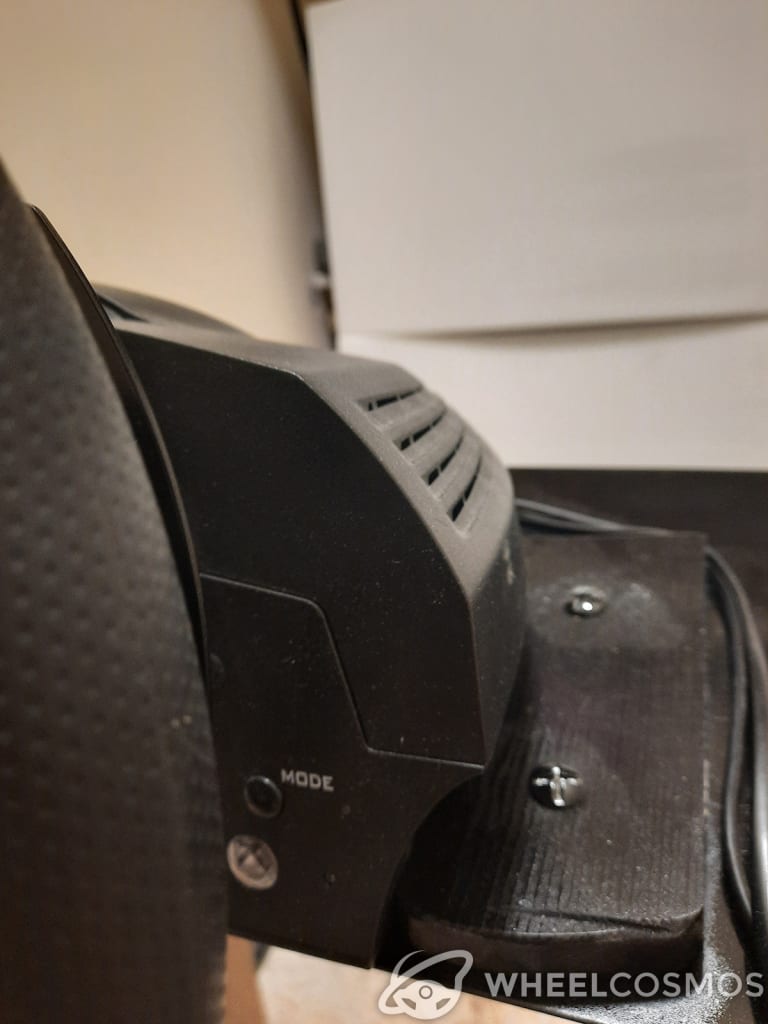
Pedals review
Technology, feel, resistance
2-pedal set: throttle & brake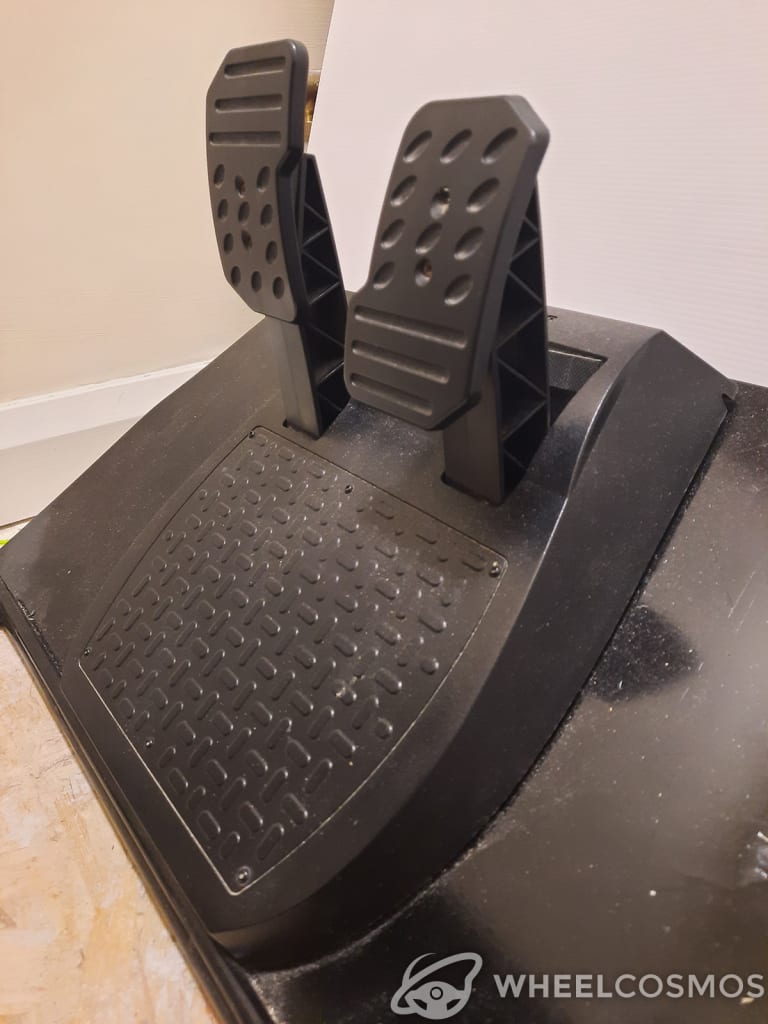
By far our least favourite thing about the wheel is not even the wheel itself.
It’s the dreadful pedals that come included with the TMX wheel. These are a 2-pedal set (Throttle, brake).
Being fully made from plastic, it’s not the strongest, or the best-looking pedal set. And we are going harsh on these because these pedals SUCK.
Both pedals use potentiometers, which is a big downside, since they are not as reliable as Logitech or even Fanatec’s cheapest pedal sets.
The lack of a load cell in the brake pedal takes away from the experience.
Load cell vs. potentiometers
Potentiometers work by measuring the resistance of a rotating wiper inside the potentiometer. Basically, measuring how much it’s turned.
The downside: this cannot measure pressure. And that’s where Load-cell is better.
Load cell measures how much pressure is applied to it, making it way more accurate than a potentiometer. They also degrade slower due to there being no moving parts!
Furthermore, the TMX brake pedals does not have a lot of resistance.
Our tip:
Get a conical brake mod, which works by attaching a rubber or plastic cone to the brake pedal. This will increase its resistance at braking.
Now, the throttle pedal: they lack resolution and any resistance. It just feels more like a toy.
Judging the braking pressure on these pedals is really hard, so it’s far too easy to lock up in-game.
At least there’s one good thing about these pedals:
They have 2 threads for hardware mounting. They also include rubber feet for smooth floors, to prevent them from sliding away under your feet. Thank god! No carpet grip, though.
The G29 pedals have much better resistance than the stock TMX pedals.
But one thing that can be done is an upgrade:
The Thrustmaster TMX is also compatible with the T3PA pedals, which you can buy separately. It’s a plug-and-play experience — and, in our opinion, a night and day difference.
If you have a bigger budget, you could even get the Fanatec CSL pedals with a USB adapter.
Upgrade path
So by now we know that the TMX is a decent wheel for beginners and new sim racers. But you might want some extra features.
Well, in Thrustmaster’s defense, they have an excellent upgrade path. Most of their wheels are plug-and-play with their more expensive pedal sets, like the T3PA, T3PA-Pro, or even the T-LCM.
Thrustmaster even sells an H-pattern shifter called the TH8A, and a sequential/ handbrake in collaboration with Sparco.
All of this beats Logitech’s single upgrade, which is an add-on shifter, which is one of the worst shifters for sim racing.
So for future-proofing, the point goes to Thrustmaster 😉
Mods
Unlike the more expensive wheels, the TMX has a fixed rim. This means you can’t put on custom rims without modding it first.
There are countless tutorials online teaching people how to fabricate and attach custom rims onto their TMX wheels. But besides that, there is not much to be tinkered with.
The competition
The TMX sets itself apart from the competition with its eye-catching price and upgrade path. But how does it stack up against other wheels?
We have done the research and listed some key differences below:
The TMX is made of plastic with a fixed rim and lacking stock pedals. It can be upgraded with better pedals, shifters, and brakes. It produces 2Nm of torque.
The G29/920/923 is made of plastic and with a fixed leather rim and a decent set of pedals made of metal. It can only be upgraded with a Logitech shifter. It produces 2.1 - 2.2Nm of torque.
The Fanatec CSL DD is made of metal with interchangeable rims. The add-on Fanatec CSL pedals are made of metal and use hall-effect sensors. It can be upgraded with Fanatec compatible rims, shifters, pedals, brakes. It produces 5Nm (8Nm with boost kit) of torque.
All of these wheels come in below €350, making them a close match.
The TMX comes out somewhere in the middle, with the advantage over the G29 with its upgrade path, but lacking the sheer power the competition gives more of.
Conclusion
The Thrustmaster TMX is a solid beginner’s wheel for under €200. It does many things well, but a lot can still be improved. Here we have a list of pros and cons:
Pros:
- Well-prices
- Good force feedback
- Smooth rotation
- Great upgrade path
Cons:
- Lacking torque
- Lacking build quality
- The pedals belong to the rubbish bin
- Grips are not the best
- Lack of hardware mounting
The TMX is definitely a solid start and a good introduction into sim racing. It offers many features which the cheaper wheels don’t have, and it has a decent force feedback.
Where it lacks behind is the software and build quality. The other flaws can be controversial, and that’s just us being picky.
If you need a force feedback wheel on the cheaper side, I definitely recommend the TMX wheel. If you can spend an extra €100, I would recommend a step-up from the TMX, the T300.
It is basically the big brother of the TMX. Bigger motor, better force feedback, and has interchangeable rims.
I would also recommend the TMX over the G29/920 purely for the fact that Thrustmaster has more upgrades and add-ons available.
I have used the TMX for a long time now and in my opinion, it’s a great wheel for beginners. It has its flaws, but they are not major enough to change a buyer’s mind. I recommend this wheel for newcomers that want to get into the world of sim racing!

